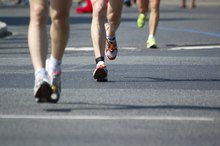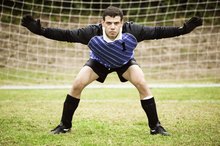What does fact checked mean?
At Healthfully, we strive to deliver objective content that is accurate and up-to-date. Our team periodically reviews articles in order to ensure content quality. The sources cited below consist of evidence from peer-reviewed journals, prominent medical organizations, academic associations, and government data.
The information contained on this site is for informational purposes only, and should not be used as a substitute for the advice of a professional health care provider. Please check with the appropriate physician regarding health questions and concerns. Although we strive to deliver accurate and up-to-date information, no guarantee to that effect is made.
Middle Distance Runners Diet
A middle-distance runner competes in track and field races that vary from about a half-mile to two miles in length. Successful competition in these events requires rigorous and time-consuming training, states SpeedEndurance.com in "Nutrition for Middle-Distance Running -- IAAF Nutrition for Athletics." Proper nutrition for middle-distance running, says SpeedEndurance.com, should be well-balanced in fat, carbohydrate, and protein intake and match the caloric expenditures of living, training and racing 124.
Fat Intake
SpeedEndurance.com states that some of the middle-distance runner's training regime involves the burning of fat 2. Thus, middle-distance runners should consume enough fat to fuel this portion of their training. SpeedEndurance.com recommends that about 30 percent of a middle-distance runner's diet be composed of healthy fats 2. In "Healthy Eating Pyramid," the Harvard School of Public Health says that sources of healthy fats include nut butter, olive oil and avocados 3.
Carbohydrate Intake
What Do Cross-Country People Have to Eat to Lose Weight?
Learn More
SpeedEndurance.com states that carbohydrate intake should also be closely monitored in the diets of middle-distance runners because most of the their training burns carbohydrates 2. Between 50 percent and 70 percent of a middle-distance runner's diet should be comprised of carbohydrates. The Harvard School of Public Health provides many examples of carbohydrates 3. They include all fruits and vegetables such as apples, oranges, green beans and spinach.
Protein Intake
SpeedEndurance.com states that protein intake should make up about 15 percent to 30 percent of a middle-distance runner's diet 2. Protein is important in the diet because it helps to re-build muscle tissues broken down during the rigors of training and racing. The Harvard School of Public Health recommends white meat, eggs and black beans as examples of protein 3.
Caloric Requirements
Should Sprinters Load on Carbs?
Learn More
Proper caloric intake for middle-distance runners will vary based upon their gender, age, weight and how much they are training. Middle-distance runners can use "Calorie Calculator" by MayoClinic.com to obtain a rough estimate of how many calories they should consume each day.
Eating Schedule
"Middle Distance Running" by the Australian Institute of Sport emphasizes two important parts of a middle-distance runner's eating schedule 14. In order to get enough calories of healthy food throughout the day, middle-distance runners should eat three complete meals and multiple snacks. Also, eating a well-balanced meal or snack within one hour of rigorous exercise helps the body to recover, says the Australian Institute of Sport 4.
Related Articles
References
Writer Bio
Meghan Hicks is an outdoor educator and running coach who began writing in 2009. She is a contributor to the iRunFar website, among others. She holds a Master of Science in resource interpretation from Stephen F. Austin State University and a Bachelor of Science in geology from Beloit College.









